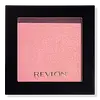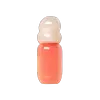Revlon Powder Blush Versus Sunnies Face Blush On
What's inside
What's inside
 Key Ingredients
Key Ingredients

 Benefits
Benefits

No benefits
 Concerns
Concerns

 Ingredients Side-by-side
Ingredients Side-by-side

Propylene Carbonate
SolventOctyldodecanol
EmollientDisteardimonium Hectorite
StabilisingTrimethylsiloxysilicate
EmollientIsododecane
EmollientDiisostearyl Malate
EmollientPhenoxyethanol
PreservativeCI 15850
Cosmetic ColorantCI 42090
Cosmetic ColorantCI 15985
Cosmetic ColorantCI 77491
Cosmetic ColorantCI 77891
Cosmetic ColorantPrunus Persica Fruit Extract
AbrasiveButylene Glycol
HumectantHydrogenated Polyisobutene
EmollientHibiscus Sabdariffa Flower Extract
Skin Conditioning1,2-Hexanediol
Skin ConditioningTocopherol
AntioxidantSorbitan Sesquioleate
EmulsifyingHydrogenated Poly(C6-14 Olefin)
EmollientPentaerythrityl Tetra-Di-T-Butyl Hydroxyhydrocinnamate
AntioxidantHydrogenated Styrene/Isoprene Copolymer
Silica
AbrasiveCamellia Japonica Flower Extract
EmollientEthylhexylglycerin
Skin ConditioningPolyglyceryl-6 Polyricinoleate
EmulsifyingAscorbyl Palmitate
AntioxidantPolyglyceryl-6 Polyhydroxystearate
EmulsifyingPolyglycerin-6
HumectantMagnolia Kobus Bark Extract
Skin ConditioningWater
Skin ConditioningPropylene Carbonate, Octyldodecanol, Disteardimonium Hectorite, Trimethylsiloxysilicate, Isododecane, Diisostearyl Malate, Phenoxyethanol, CI 15850, CI 42090, CI 15985, CI 77491, CI 77891, Prunus Persica Fruit Extract, Butylene Glycol, Hydrogenated Polyisobutene, Hibiscus Sabdariffa Flower Extract, 1,2-Hexanediol, Tocopherol, Sorbitan Sesquioleate, Hydrogenated Poly(C6-14 Olefin), Pentaerythrityl Tetra-Di-T-Butyl Hydroxyhydrocinnamate, Hydrogenated Styrene/Isoprene Copolymer, Silica, Camellia Japonica Flower Extract, Ethylhexylglycerin, Polyglyceryl-6 Polyricinoleate, Ascorbyl Palmitate, Polyglyceryl-6 Polyhydroxystearate, Polyglycerin-6, Magnolia Kobus Bark Extract, Water
Ingredients Explained
These ingredients are found in both products.
Ingredients higher up in an ingredient list are typically present in a larger amount.
Ci 77491 is also hydrated iron III oxide. It's sole purpose is to give a red/pink hue to products.
Iron III oxides are classified as inorganic chemicals for coloring.
Synthetically created Ci 77491 is considered safer than those naturally found. This is because the synthetically created version may contain less impurities. Iron oxides are generally non-toxic and non-allergenic.
Learn more about CI 77491